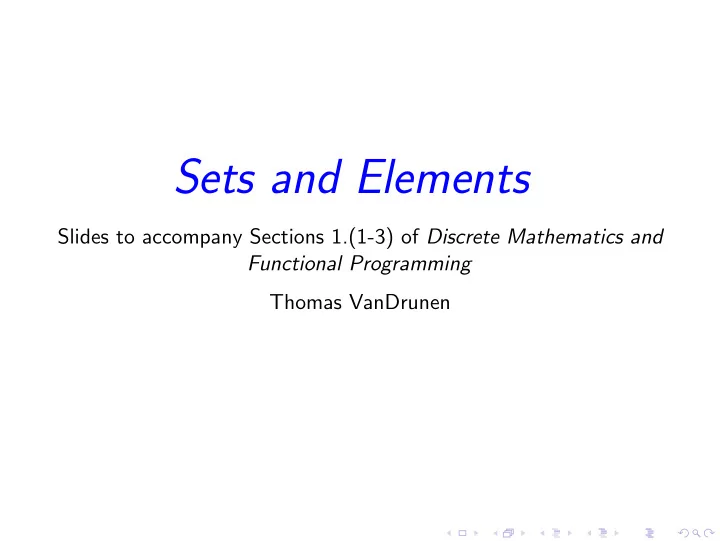

Sets and Elements Slides to accompany Sections 1.(1-3) of Discrete Mathematics and Functional Programming Thomas VanDrunen
Categories of numbers W 0 N 5 Natural numbers and whole numbers .
Categories of numbers Z W 0 N 5 −5 Adding integers .
Categories of numbers Z W 0 N 5 −5 Adding integers .
Categories of numbers Z Q W 0 N 3 5 −5 7 Adding rationals .
Categories of numbers √ π 2 1 1 1 Measurable real-world lengths that are not rationals.
Categories of numbers R A √ 2 T Z Q W π 0 N 3 5 −5 7 Differentiating algebraic numbers from transcendental numbers .
Categories of numbers R A √ 2 T Z Q W π 0 N 3 5 −5 7 R − Differentiating negative numbers .
Categories of numbers R A √ 2 C T Z Q W 2 i + 3 π 0 N 3 5 −5 7 R − Adding complex numbers .
Categories of numbers 5 is a natural number ( or the collection 5 ∈ N of natural numbers contains 5). Z ⊆ Q All integers are rational numbers. Merging the algebraic numbers and the R = A ∪ T transcendental numbers makes the real numbers. Z − = R − ∩ Z Negative integers are both negative and integers. T = R − A Transcendental numbers are those real numbers that are not algebraic numbers.
Categories of numbers Nothing is both transcendental and al- T ∩ A = ∅ gebraic, or the collection of things both transcendental and algebraic is empty. Adding 0 to the collection of natural W = { 0 } ∪ N numbers makes the collection of whole numbers. Since all rational numbers are algebraic Q ⊆ A numbers and all algebraic numbers are A ⊆ R real numbers, it follows that all rational Q ⊆ R ∴ numbers are real numbers.
Primitive terms √ Things like 5, 3 7 , 2, π , 2 i + 3 are elements . Things like N , Z , Q , R , and C are sets . Primitive terms are ideas too basic to define; we use them in defining other terms. Set and element are primitive terms of set theory just as point , line , and plane are primitive terms of geometry.
Primitive terms and axioms Instead of defining primitive terms, we define their relationships among them. Here are two axioms of set theory (a complete axiomatic formulation requires many more): Axiom (Existence.) There is a set with no elements. Axiom (Extensionality.) If every element of a set X is an element of a set Y and every element of Y is an element of X, then X = Y .
Set notation The empty set: ∅ or {} Explicit listing of elements (sets are unordered, so order doesn’t matter): { Red , Green , Blue } = { Green , Blue , Red } = { Blue , Red , Green } = { Blue , Green , Red } Membership of an element: Red ∈ { Green , Red }
Set notation Defining a set as a restriction on a larger set: N = { x ∈ Z | x > 0 } This means the set of natural numbers is the set of elements x drawn from integers with the restriction that x > 0. Other ways to define sets exist, such as “interval” notation you saw in high school or earlier: (1 , 5] = { x ∈ R | 1 < x ≤ 5 }
Recommend
More recommend